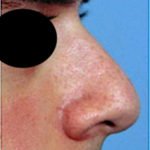While rhinoplasty is one of the most sought after plastic surgery procedures, it is also one of the most challenging to perform. Its complexity of numerous anatomic elements coming together to form the many subtle shapes of the nose allows a lot of different factors to come into play in what will result in the final outcome. The challenges of rhinoplasty are often magnified in the male patient for a variety of reasons.
I find that male plastic surgery patients in general tend to have two distinct characteristics that can make for a more difficult experience. They tend to be more demanding than women in terms of the final result and they usually pay less attention during a consultation. They often shake their head like they are understanding or may unconsciously act like what you are saying they already know. These two characteristics are particularly apparent in the young male patient, which just happens to make up a large percent of the male rhinoplasty population. Some describe men as having a poorer understanding of their problem and being able to less accurately describe what they want…but this has not been my Indianapolis plastic surgery practice experience. Most of the men I have seen are usually quite specific about what they want and have often studied their problem in detail…. sometimes in too much detail. It is of great concern to me when the patient comes in with drawings and numerous images of themselves that they have photographed and analyzed or even computer imaged.

From an execution standpoint, rhinoplasty in men is more about producing subtle improvements than dramatic sweeping changes. This is so for two reasons. First, the thickness of male nasal skin does not lend itself to seeing some of the changes that have been made to the underlying bone and cartilage framework. As a result, finesse sculpting a male nose is more theoretical than reality. Some basic changes can be made but making fine detailed changes is more difficult. The thickness of the male skin will also lead to more prolonged postoperative swelling, particularly in the tip area. Secondly, men do not look good with an overlying refined or too small of a nose. Take a look at Michael Jackson for example to see that point well illustrated. A hump reduction, nasal bone narrowing, and some tip modifications are the three basic changes where improvements can be seen and still keep a male nose looking…male.
Dr. Barry Eppley
Indianapolis, Indiana



